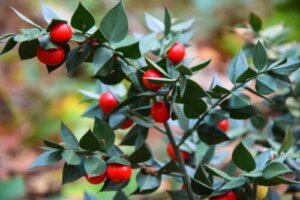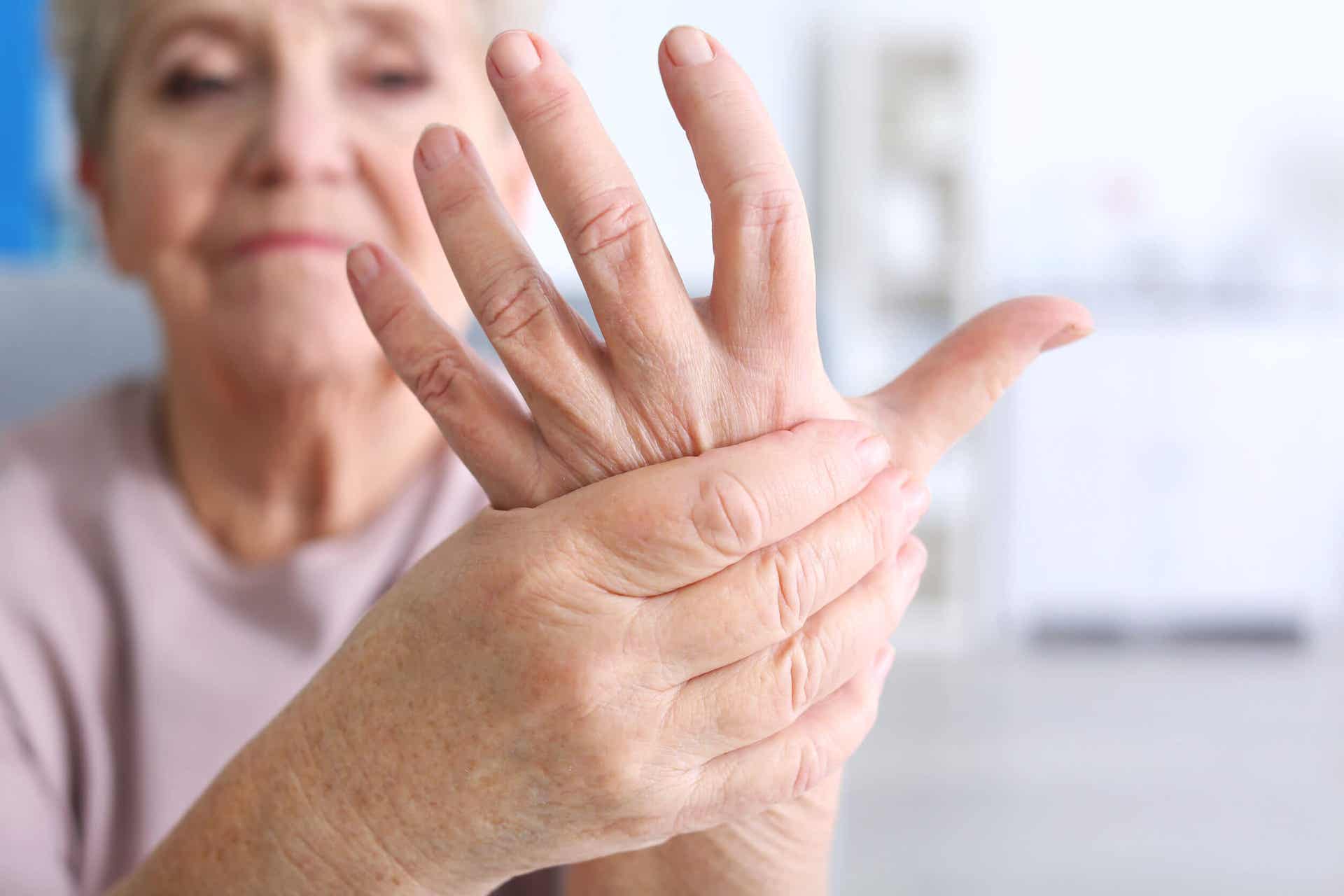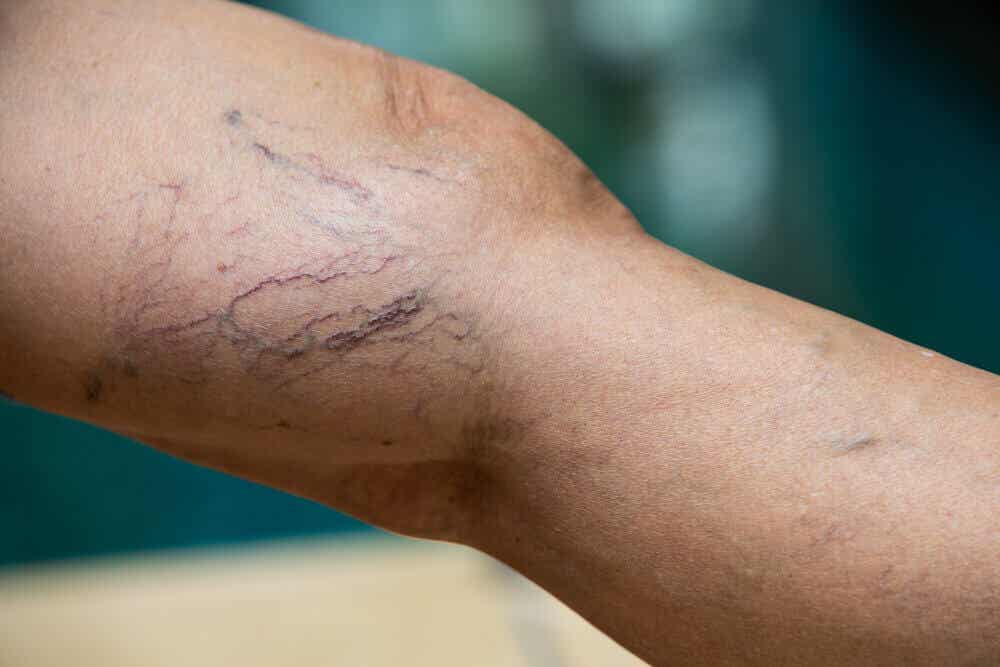Butcher's Broom: Active Ingredients and Benefits


Reviewed and approved by the pharmacist Franciele Rohor de Souza
Butcher’s broom (Ruscus aculeatus), also known as “holly” or “wild myrtle,” is a small evergreen shrub that develops several stiff branches. In fact, it’s known as “butcher’s broom,” since in ancient times butchers bundled its branches to sweep up their chopping blocks.
The plant comes from Western Europe, although it’s also found in North Africa and Asia. Today, its roots are used in supplementation as its active principles are associated with several potential health benefits.
What does the research say?
Find out right here!
Active ingredients of butcher’s broom
Because of its wide use in natural medicine, butcher’s broom has been the source of much research.
Thus, doctors have determined that many of its active biochemical compounds justify its use as a natural remedy. Of course, studies are still ongoing and there’s still no solid evidence to consider it as a first-choice treatment. Still, specialists have identified its pharmacological substances.
It’s important to note that we obtain the active principles from the rhizome and root. We must exclude other parts, such as the fruits, as they contain toxic compounds. According to data compiled in the scientific journal Molecules, its most prominent compounds of interest are the following:
- Ruscogenin and neo-ruscogenin (steroidal saponins), which have anti-inflammatory and venotonic properties, according to research
- Flavonoids, such as rutoside and hesperidin, are attributed to a diuretic and anti-edematous effect
- Triterpenes
- Mineral salts, especially potassium
- Resins
- Traces of essential oil
You may also like: Essential Oils For Winter Illnesses
Uses and benefits of butcher’s broom
Because of its particular composition, butcher’s broom is considered an anti-inflammatory, diuretic, venotonic, and capillary protector remedy. However, many of its applications come from traditional practice and conclusive scientific studies do little to support it. For now, some research has made promising findings.
Anti-inflammatory activity
Chronic inflammatory states are associated with an increased risk of disease. Thus, we must control it to avoid health deterioration.
In this sense, butcher’s broom seems to have potential benefits. Research reported in the Journal of Pharmacological Sciences highlights that ruscogenin, one of its active compounds, decreases inflammation markers.
Similarly, a study in the Archives of Pharmacal Research supports these mechanisms. In particular, it concludes that ruscogenin helps stop the production of an enzyme that causes cartilage degradation in arthritic disorders.

Adjuvant against venous disorders
One of the main uses of butcher’s broom is for blood circulation. Its abundant flavonoid content is related to benefits at the vascular level. To be more precise, the plant contains substances that stimulate the alpha-adrenergic receptors that cause the veins to contract.
In research shared by International Angiology, it was determined that a Ruscus aculeatus supplement with ascorbic acid (vitamin C) helped reduce symptoms and edema in patients with chronic venous disorders. Specifically, it reduced leg pain, heaviness, and the sensation of swelling.
Hemorrhoids prevention
In traditional medicine, butcher’s broom has been a preventive supplement against hemorrhoids. Some believe it helps reduce swelling and stimulate vein contraction. On the other hand, a study in Alternative and Complementary Therapies found that 69% of people who supplemented with butcher’s broom had fewer hemorrhoid symptoms, such as pain and irritation.
Other possible benefits of butcher’s broom
Several butcher’s broom benefits come from anecdotal data and its uses in natural medicine. Therefore, you should use its supplements sparingly.
According to information from the U.S. corporation WebMD, there’s insufficient evidence for the following:
- Diabetic retinopathy
- Low blood pressure on rising
- Varicose veins
- Swelling of the arms due to lymphedema
- Constipation
- Restless legs syndrome
- Premenstrual syndrome
- Fractures
- Fluid retention
- Gout or hyperuricemia
- Kidney stones
- Lumbar pain
Possible side effects of butcher’s broom
Specialists consider butcher’s broom supplements safe for most people when taken orally for up to 3 months. However, in some people, it may cause unwanted reactions, such as heartburn, nausea, vomiting, and diarrhea.
In a case report reported in the Journal of Emergency Medicine, a woman with diabetes developed ketoacidosis after taking this plant. However, specialists don’t know if the underlying cause was butcher’s broom or other factors.
You shouldn’t take it concurrently with blood pressure or kidney disease medications as there may be possible interactions. In these cases, it’s best to consult a doctor first. Children, pregnant and breastfeeding women should also steer clear.
It should be considered that the saponins of this plant act as anti-nutrients. Therefore, consuming it may reduce the absorption of essential minerals such as zinc and iron.

Dosage and recommendations
At present, specialists haven’t defined an exact dosage for the consumption of butcher’s broom. The recommended amount may vary according to age, sex, and medical history, among other factors. Therefore, you must respect the dosage suggested on the supplement label.
In general, here are some basic guidelines:
- Dried root: From 0.05 to 0.10 ounces (1.5 to 3 grams) per day
- Tablets: Up to 200 milligrams, 2 or 3 times a day
- Tinctures or extracts: 3 to 6 milliliters per day
Similarly, there are ointments, syrups, and other products containing this plant available.
What to remember about butcher’s broom
Butcher’s broom supplements are known for their effects on blood circulation and associated disorders. You can find them in herbal stores or pharmacies, alone or combined with other plants and substances. Although some studies support its benefits, you should remember that it doesn’t replace medical treatment.
In any of its presentations, you should use the plant sparingly, according to professional or label indications. If there’s an underlying disease or if you’re taking medication, you should ask your doctor first.
All cited sources were thoroughly reviewed by our team to ensure their quality, reliability, currency, and validity. The bibliography of this article was considered reliable and of academic or scientific accuracy.
- Ruscus aculeatus (butcher’s broom). Monograph. Altern Med Rev. 2001 Dec;6(6):608-12. PMID: 11804550.
- Masullo M, Pizza C, Piacente S. Ruscus Genus: A Rich Source of Bioactive Steroidal Saponins. Planta Med. 2016 Dec;82(18):1513-1524. doi: 10.1055/s-0042-119728. Epub 2016 Nov 8. PMID: 27825178.
- Rodrigues JPB, Fernandes Â, Dias MI, et al. Phenolic Compounds and Bioactive Properties of Ruscus aculeatus L. (Asparagaceae): The Pharmacological Potential of an Underexploited Subshrub. Molecules. 2021;26(7):1882. Published 2021 Mar 26. doi:10.3390/molecules26071882
- Lopez-Candales A, Hernández Burgos PM, Hernandez-Suarez DF, Harris D. Linking Chronic Inflammation with Cardiovascular Disease: From Normal Aging to the Metabolic Syndrome. J Nat Sci. 2017 Apr;3(4):e341. PMID: 28670620; PMCID: PMC5488800.
- Huang YL, Kou JP, Ma L, Song JX, Yu BY. Possible mechanism of the anti-inflammatory activity of ruscogenin: role of intercellular adhesion molecule-1 and nuclear factor-kappaB. J Pharmacol Sci. 2008 Oct;108(2):198-205. doi: 10.1254/jphs.08083fp. PMID: 18946195.
- Lim H, Min DS, Kang Y, Kim HW, Son KH, Kim HP. Inhibition of matrix metalloproteinase-13 expression in IL-1β-treated articular chondrocytes by a steroidal saponin, spicatoside A, and its cellular mechanisms of action. Arch Pharm Res. 2015 Jun;38(6):1108-16. doi: 10.1007/s12272-015-0581-z. Epub 2015 Feb 25. PMID: 25712888.
- Memorial Sloan Kettering Cancer Center. Butcher’s broom. September 11, 2015
- Kakkos SK, Allaert FA. Efficacy of Ruscus extract, HMC and vitamin C, constituents of Cyclo 3 fort®, on improving individual venous symptoms and edema: a systematic review and meta-analysis of randomized double-blind placebo-controlled trials. Int Angiol. 2017;36(2):93-106. doi:10.23736/S0392-9590.17.03815-9
- MacKay D. Hemorrhoids and varicose veins: a review of treatment options. Altern Med Rev. 2001 Apr;6(2):126-40. PMID: 11302778.
-
Abascal, K., & Yarnell, E. (2005). Botanical Treatments for Hemorrhoids. Alternative and Complementary Therapies, 11(6), 285–289. https://doi.org/10.1089/act.2005.11.285
-
Vanscheidt W, Jost V, Wolna P, Lücker PW, Müller A, Theurer C, Patz B, Grützner KI. Efficacy and safety of a Butcher’s broom preparation (Ruscus aculeatus L. extract) compared to placebo in patients suffering from chronic venous insufficiency. Arzneimittelforschung. 2002;52(4):243-50. doi: 10.1055/s-0031-1299887. PMID: 12040966.
This text is provided for informational purposes only and does not replace consultation with a professional. If in doubt, consult your specialist.








